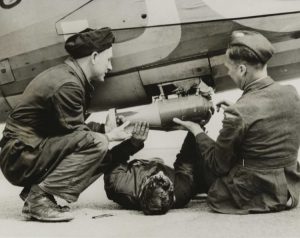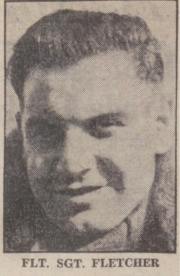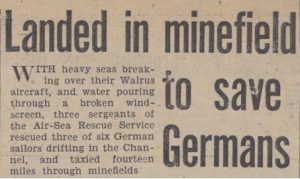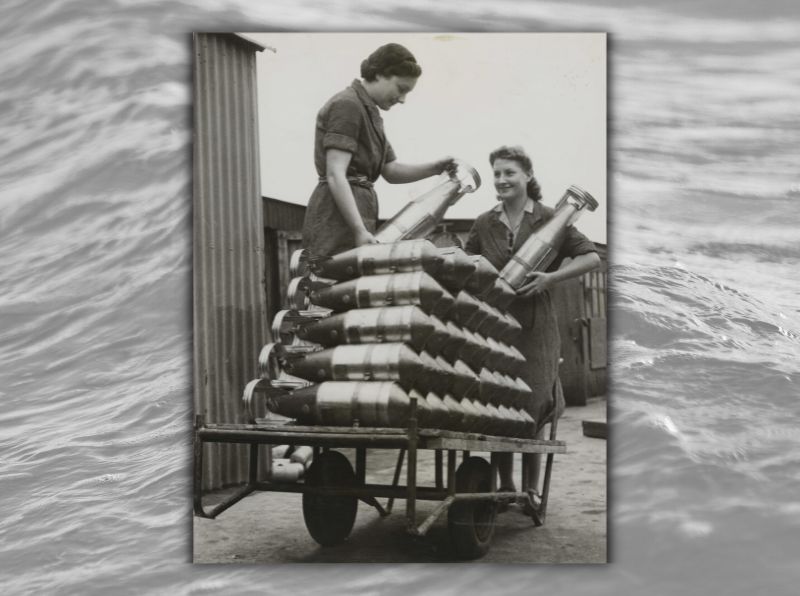In the above photo, munitions workers at a factory in the south of England stack smoke floats for aircraft in October 1941, ready for despatch.
These curious-looking items played an important role during WWII. Contrary to their design, they were not intended for use as ammunition. What was a smoke float, and how were they used during the war? Let’s take a closer look at this intriguing invention.
Serving on and over sea
The Royal Air Force and the Royal Navy were pivotal to Britain’s war effort during WWII. The Royal Navy carried out important operations at sea around the world, from the Atlantic to the Pacific. At the same time, the RAF flew countless sorties and missions against the enemy and enemy-occupied territory. Their work inevitably involved crossing seas and oceans with the vast, unforgiving waters stretched out below them. Unsurprising, owing to the nature of war, airmen and seamen alike found themselves stranded at sea. At times, the human eye may have been able to spot these stricken individuals, but their position had to be marked before they were lost again. This is where smoke floats come in.
Smoke floats
According to the image caption: when a pilot spots seamen in distress or pilots who have been forced to bale out over the sea, they drop a smoke float to let them know they have been seen. When the float hits the water, it causes the composition inside to ignite, giving off a cloud of smoke which serves as a guide to rescue craft. The sight of billowing smoke must have brought hope to those struggling to stay afloat in the water.

The caption for the image above offers another use of smoke floats: to screen rescue work from possible enemy craft. They proved to be of great assistance to Sergeant Thomas Fletcher during a rescue flight near the coast of Dover in December 1942.
Sergeant Thomas Fletcher, RAF Air Sea Rescue

Sergeant Thomas Fletcher, already the recipient of the Distinguished Flying Medal (D.F.M.), was recommended for the Bar to his D.F.M. when he courageously attempted to rescue six German sailors stranded in the Channel in December 1942. Thomas’s full citation, edited below, is available on Forces War Records through the Recipients of the Distinguished Flying Medal, 1939-1945 collection. The daring rescue attempt makes for gripping reading:
At 16.36 hours on 14th December 1942, three to four men were sighted in a dinghy eight to ten miles east of Dover. At 16.45 hours, Sergeant Tom Fletcher, “C” Flight, No.277 Air Sea Rescue Squadron, Hawkringe, as pilot of an Air Sea Rescue Walrus [amphibious aircraft manufactured by Supermaine], was ordered to take off. He was accompanied by Flight Sergeant Glew, D.F.M. and Flight Sergeant Healey, D.F.M., as Air Gunners.
On arriving over the position, Sergeant Fletcher saw six men on a raft and, in spite of the fact that the sea was too rough to take off again, he immediately dropped a smoke float and landed with the intention of picking up the men and taxiing back to harbour. He taxied up to the raft, and Flight Sergeant Glew handed the boathook to one of the men who was helped into the back hatch, leaving the others on the raft. With difficulty, Sergeant Fletcher taxied around and came back to the raft a second time, but the men missed the rope and were knocked off the raft by waves. They clambered back, and the pilot taxied around again. This time, one of the men seized the rope and was pulled on board. The rest were knocked off the raft by a large wave, and one was knocked unconscious by the hull of the Walrus. Two of the men in the water tried to swim towards the Walrus, but, owing to the rough sea, it was impossible to pick them up.
Sergeant Fletcher found the raft once more with one man aboard who was pulled into the hatch by Flight Sergeant Glew. By this time, it was completely dark, and there was no sign of the men in the water. Sergeant Fletcher, therefore, started to taxi back to Dover.
The starboard windscreen on landing had been smashed in by the sea, and water had been continuously shipped through the hatches, the waves breaking over Flight Sergeant Glew in the front hatch the whole time, a lot of water being shipped through both hatches and the R/T [Radio Transmitter] and intercommunication also failed. By the time the pilot started to return, there were 18 inches of water in the Walrus, which the Air Gunners tried to bail out, but the sea coming through the windscreen kept the level of water up.
Owing to these factors, it took Sergeant Fletcher half an hour to turn his aircraft onto the course for Dover and approximately one hour before he reached the mouth of the harbour and was guided in by a trawler.
During the course of his journey home, Sergeant Fletcher carried out the rescue with conspicuous coolness and skill under extremely difficult conditions and finally brought his aircraft back to Dover after a long and hazardous taxi in difficult and dangerous water conditions. This was the seventh successful rescue at sea undertaken by Sergeant Fletcher in the course of which this pilot has directly contributed to the rescue of thirteen people.

The Air Officer Commanding ‘very strongly’ recommended Sergeant Fletcher for the immediate award of a Bar to the D.F.M. and a commission in the field.
It’s a testament to Sergeant Fletcher’s determination and dedication to duty that he endured such significant risk to rescue men deemed his enemy. He was aided, in no small part, by smoke floats manufactured for rescues of this nature.
What stories will you uncover in the records? Start your search with Forces War Records today.
Cover Photo: © Hulton Archive/Getty Images


